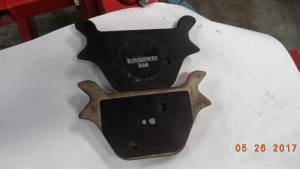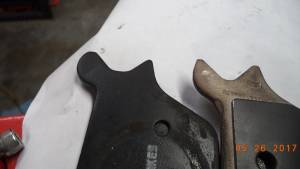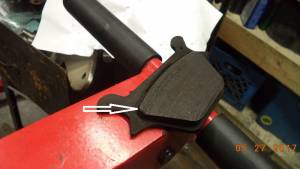Table of Contents
REF: Wheels, Brakes & Tires
Brake Pads - Aftermarket, Break-in etc
Brake Pad Material
There are 3 common types of formulation for a brake pad friction material. 1)
- Organic:
- Organic brake pads inherit their name from the organic phenolic resins used to bind together the different compounds used in the pads construction.
There are countless different types of thermoset phenolic resin.
But they can all be generally considered to have a maximum temperature up to which they are thermally stable.
Above it's max operating temp, the phenolic resin binding agent becomes altered by heat.
And it effectively ‘boils’, expelling an appreciable volume of gas as it degrades.
- Sintered metallic: 2)
- This is the fusing together under, heat and pressure, of metallic particles and blending of various other elements to enhance friction properties and wear life.
Although attempts were made by the OEMs to cut costs of Sintered brakes by using sintered IRON, that was deemed a failure and these days the base material is copper. - The advantage of the sintered metal pads are that a more compact brake pad in size can be made which also has considerable durability advantages over its earlier stablemates. 3) This allows the brake caliper to be smaller and reduces the all important unsprung weight of a motorcycle. Sintered brakes are usually made from a copper alloy blend although sintered iron was tried with little success for cost reasons in the 90’s.
- Semi-metallic:
- These are a ‘hybrid blend’ of one and two above.
They have properties that typically lie somewhere in the middle of both.
Brake Pad Break-in (burnishing)
The forgoing applies to factory brake pads and discs only.
When using aftermarket pads / discs, refer to the manufacturer for the proper break-in procedure.
Burnishing is the process that occurs as the pads and disc wear into one another. 4)
Burnishing is complete when the pad and disc contact surfaces are fully worn into each other, thus providing maximum contact.
Early disc brake systems with organic type pad materials needed fairly harsh break-in braking to burnish the disc and pads.
The 86-90 FSM says to burnish by applying several hard stops after new pads have been installed. 5)
This, of course, is assuming you are using the factory 86-90 organic brake pads.
Note: Using 1991 and earlier brake pads with 1992 stainless steel rotors will cause premature rotor wear. 6)
For maximum service life, a new brake rotor should only be installed with the recommended replacement brake pads.
If you install a new rotor, also install the recommended brake pads for that particular rotor.
1992 Brake Pads and Stainless Steel Brake Discs.
With the change in brake disc and pad material for 1992, comes a change in the break in burnishing procedure.
The new combination of a softer disc and more aggressive sintered metal pads allows the normal burnishing process to scratch the disc more than before.
This grooving is normal and will diminish after burnishing is achieved.
With the new combination, burnishing can no longer be achieved by making repeated hard stops.
In fact, this practice can cause premature wear.
Repeated hard stops can generate excessive heat causing material transfer between pads and disc.
Burnishing pads and discs can only be done properly by normal brake operation through the vehicle's break-in
period.
Brake Fade
(Article from EBC brakes) 7)
Brake fade is described as the temporary reduction or complete loss of braking power.
8)
Brake fade occurs when the brake pad and the brake rotor no longer generate sufficient mutual friction to stop the vehicle at it's preferred rate of deceleration.
The end result being inconsistent or unexpected braking system behavior, often resulting in increased stopping distances.
Brake fade is caused by overheating of the brake pad. Therefore all brake pads have the potential to develop brake fade.
Because it occurs when the brake pads are overheated, the phenomenon is only temporary and braking performance usually returns once the brakes have cooled down.
It is worth noting that brake fade is not the cause for a long or spongy brake pedal/lever.
If you experience a spongy pedal/lever you’ve probably got air in your brake system or have boiled your brake fluid.
Brake pads are designed to work within certain operating temps. If used outside this operating window the braking system will underperform.
The friction compound of modern organic brake pads is a mix of many different materials which perform differently under temperature.
How these materials respond at elevated temps defines their performance characteristics, including the temperature at which brake fade occurs.
Different formulations of brake pads can therefore perform very differently from each other and it's important to use the right pad for the right application.
There are two very different kinds of brake fade
- Green fade or early life brake fade:
- This is quite common and almost normal when new brake pads are fitted.
It is merely a settling down of the components after install and can be gone in a few brake applications.
To minimize or avoid this effect it is wise to drive cautiously when new brakes are fitted and give yourself a little extra braking distance for the bedding in period.
The bedding in period for new pads can be anywhere up to 500 miles urban use. - You can shorten the green fade period by using the brakes positively on a quiet and safe stretch of road.
Get the pads up to a moderate temperature and thus burn off some of the volatiles that cause early life brake fade.
But before doing this, ensure the brake pads have seated properly and established full contact across the rotor face.
(this is easy to see with EBC rotors as it is the point when all the black coating has been scrubbed off the pad track).
Take care not to be over aggressive on your newly installed pads during this process, otherwise you can do more harm than good, potentially resulting in glazed rotors.
Or, the development of ‘hot spots’ on the rotor face. A few moderate stops from 50mph to 10mph should be adequate to push through the green fade period. - Some brake pads are now “surface scorched”, a process which burns off surface organics and volatiles in the pad and almost completely eliminates green fade.
- Brake pads are, to a degree, porous.
Hence they will absorb a small percentage of water vapor from the surrounding air between the date of manufacture and the date they are first fitted to a vehicle.
Water, of course, boils and turns to gas at much lower temperatures than the other constituents of the brake pad. (hence early instances of green fade which are observed at very low temperatures are a result of the emission of water content in the pad.)
This water vapor will quickly burn off as soon as you get some temperature into the pads.
- Dynamic fade or in stop brake fade (loss of brake during the stop outside the bed in period):
- This is more serious and means that you have either chosen or been sold the wrong grade of pad for your vehicle, driving style, or the pad is of general low quality.
Brake fade could also be caused by caliper drag if the caliper (particularly sliding pins) has not been properly maintained.
Poor sliders don't allow the caliper to fully release after brake application.
Dynamic brake fade is dangerous and needs to be remedied.
Dynamic brake fade is particularly undesirable during fast road or track driving since once the driver has committed to stopping their vehicle within a certain distance, there is very little they can do mid braking zone to make the correction.
In the early days of drum brakes, brake fade was more prevalent. Cooling of drum brakes was minimal and meant that heavily loaded or towing vehicles braking down a long descent could superheat the brake shoes, causing the surface of the friction material to vaporize inside the brake drum and leading to an almost complete loss of braking power. Traffic authorities even built vehicle run off sand traps as an emergency route for vehicles descending out of control. Modern disc brake systems (particularly those with vented discs) exhibit much better cooling and use modern advances in metallurgy and brake materials which all contribute to vastly improved braking performance. But there are of course many different brake pad qualities in today’s world markets and if not careful with their brake pad selection, drivers can still be subjected to in-stop brake fade, even when driving at reasonable speeds on the public highway.
For either heavily loaded vehicles, fast road drivers or race drivers who frequently reach high speeds, having a brake pad which can handle the extra braking demand is absolutely critical in order to achieve acceptable levels of performance. Remember, when you are decelerating, your brakes are converting the kinetic energy into friction and then heat. Since kinetic energy rises with the square of velocity, a stop from high speed puts an exponentially increased demand on the brake system and this generates a great deal more heat. For example, doubling vehicle speed would not double the demand on the braking system, it actually increases demand by a factor of 2² = 4. Similarly, kinetic energy also rises in proportion to vehicle mass, so a heavily laden vehicle that is loaded to double the weight actually doubles the amount of heat generated during each braking event. If not dissipated effectively or if the vehicle is fitted with brake pads that cannot cope with the extra heat, the heat build up could cause undesirable in-stop brake fade, resulting in a decrease in brake effectiveness. Drivers who regularly make several high energy stops in quick succession (such as fast road drivers or race drivers) should absolutely consider using performance pads and grooved rotors, or even consider completely upgrading over the stock braking system by installing an oversize brake kit.
Underlying Mechanisms and Principles That Cause Brake Fade:
The dominant mechanism causing brake fade is this thermal degradation of the phenolic resins and other materials in the friction lining, which create a film of gas at the pad-rotor interface and effectively causes the brake pad to skid off the disc. As these gasses build up at the pad-rotor interface, they produce an appreciable backpressure which creates an opposing force to the brake caliper that is trying to hold the pads against the rotor. If there is no way for the gasses to escape, the opposing force as a result of the outgassing can become large enough to pry the pads away from the rotor, reducing the area of pad in contact with the rotor and thus reducing braking power (i.e. brake fade).
Providing a means for these gasses to vent is an effective method to reduce the severity of brake fade. For this reason, many brake manufacturers offer slotted and dimpled brake rotors that help sweep away the gas build up every time a slot or dimple passes over the pad surface.
Consequently, the best and most effective way to prevent the gaseous build up that causes brake fade is to choose the correct pad that is designed to work at the operating temperatures it will regularly be subjected to.
Additionally, if you are experiencing brake fade it does not necessarily mean you are using a brake pad of general poor quality. What it does mean is that you are operating the brake pad at conditions it was not designed to cope with and you consider upgrading to a higher performance pad (also check the brake caliper isn’t dragging). One of the key differences between low and high performance organic brake pads is the maximum temperature they can withstand before thermal deterioration of the friction lining becomes significant. I.e. the maximum temperature the brake pad can cope with before it begins to rapidly outgas, causing brake fade.
Caliper Lube
See also Bleeding the Brake Lines In the REF section of the Sportsterpedia.
- Brake caliper mounting bolt O-rings- Dow Corning 44 grease (“Pin Lube” in parts kit) 9)
- O.D. of brake caliper piston (including chamfer), caliper piston bore and I.D. of the installed piston seal - Novaguard silicon grease.
- I.D. of upper caliper (threaded) bushing bore, O.D. of threaded bushing, I.D. of upper and lower caliper mounting pin bores - Dow Corning 44 grease (“Pin Lube” in parts kit) 10)
Aftermarket Brake Pads
Aftermarket brakes vs OEM brakes Check fitment of aftermarket brakes before using them. Just because they are published as 'will fit your vehicle' doesn't make it so. The pics below are a comparison of OEM brakes and an aftermarket brand:
 |  |
| These 2 different brand of brakes look very similar. 11) | The OEM pad on right has sharper contours 12) |
The light colored OEM brake has sharper contours to match up to the screw mounting bracket shims it rides against. The aftermarket brand is slightly shorter in length than OEM which allows it to wiggle around a bit since it doesn't fit tight against the screw shims which can allow it to drop below the disc resulting in poor pad wear and possible disc wear or disc drag as in the pic below:
Be sure your brakes can not wiggle around before installing the caliper.

